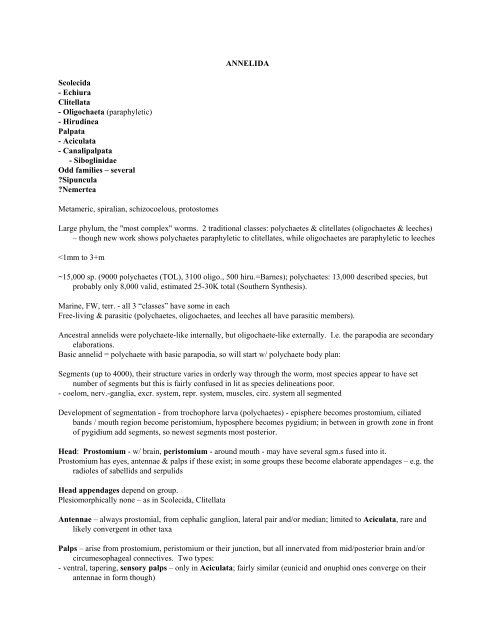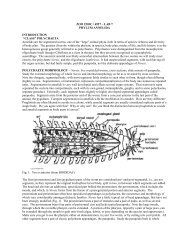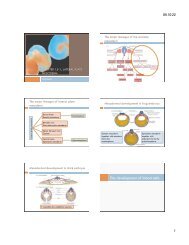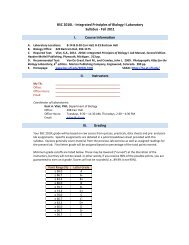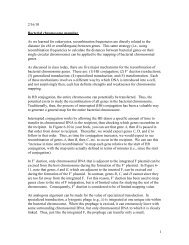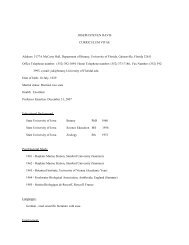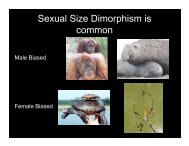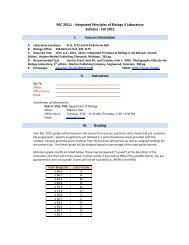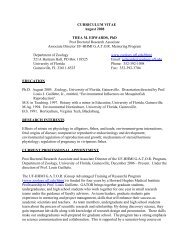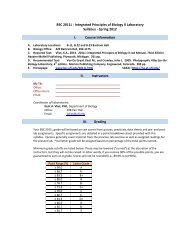Lecture Notes 7: Annelida
Lecture Notes 7: Annelida
Lecture Notes 7: Annelida
Create successful ePaper yourself
Turn your PDF publications into a flip-book with our unique Google optimized e-Paper software.
Scolecida<br />
- Echiura<br />
Clitellata<br />
- Oligochaeta (paraphyletic)<br />
- Hirudinea<br />
Palpata<br />
- Aciculata<br />
- Canalipalpata<br />
- Siboglinidae<br />
Odd families – several<br />
?Sipuncula<br />
?Nemertea<br />
Metameric, spiralian, schizocoelous, protostomes<br />
ANNELIDA<br />
Large phylum, the "most complex" worms. 2 traditional classes: polychaetes & clitellates (oligochaetes & leeches)<br />
– though new work shows polychaetes paraphyletic to clitellates, while oligochaetes are paraphyletic to leeches<br />
- grooved feeding palps – only in Canalipalpata; tend to be U shaped, with ciliated path in groove serving to<br />
transport food. Grooved palps dorsal and attached at prostomial-peristomial junction. Include paired spionid<br />
palps, multiple terebellid tentacles (arise from prostomium), radioles of sabellids, buccal tentacles (again<br />
multiple – e.g. Pectinariidae)<br />
Segments: each w/ own separate, paired coelomic compartments; separated by septa & mesenteries.<br />
Body wall:<br />
Cuticle (collagenous, may contain scleroprotein),<br />
Epidermis, circular, longitudinal muscle, peritoneum.<br />
Circular muscle as sheet, long muscle in 4 bands in almost all (Rouse & Fauchald 1997)<br />
Parapodia:<br />
Notopodium, neuropodium, if loose one always loose notopodium.<br />
Nereid type advanced, primitively low, brasing structures, without aciculas, little musculature, noto- and neuropodia<br />
separate.<br />
In evolution may become more muscular and gain aciculae (in Aciculata) and gain strong intrinsic musculature for<br />
chaetae & whole paddle; for swimming, etc. Or reduced to chaetae only (clitellates). Dorsal and ventral cirri –<br />
fleshy extensions; funky chaetae – aphroditids; scale of polynoids; specialized gills<br />
Parapodial muscles evolve from circular musculature<br />
Dorsal and ventral cirrus – outgrowths of body wall – mainly in Aciculata<br />
Aciculae – in Aciculata only. Fully internalized chaetae, with strong muscles that help support and move large<br />
parapodia. Neuropodia have it, notopodial aciculae also in many Eunicida and Phyllodocida<br />
Neuropodia reduced to low welts = tori in many Scolecida & Canalipalpata<br />
Chaetae: Chitinous, produced by chaetoblasts, has dynamic microvilli w/ start & stop activities, make complex<br />
morphologies as a result. Variety of chaetal types, hooks, capillaries, uncini, compound. Chitin restricted to<br />
protostomes. Setae - term for arthropod cuticle-coated structure w/ core of cells -- chaetae solid, secreted str.s.<br />
Body cavity: Coelom, lined by peritoneum; prd. cavities in each segment, each of independent schizocoelous<br />
origin; no coelom in unsegments. Peritoneum surrounds guts, blood vessels & nerves in middle in retroperitoneal<br />
spaces. Septa = double peritoneum. Excretory organs & gonads associated w/ coelom. Advantages<br />
include greater possibilities for locomotion, localization of injuries. Some polychaetes loose septa between<br />
some segments and create larger, confluent coelomic spaces. Some (especially small, interstitial worms) loose<br />
segmentation and coelom altogether.<br />
Locomotion:<br />
Circular & long. muscles together w/ hydrostatic skeleton for peristaltic locomotion - a segment at a time. A major<br />
advantage of segmentation, is in locomotion: localized coelomic fluid, together with local contraction of<br />
segmental muscles, allows the local widening or elongation of segments. Septa - give local control of<br />
movement. Peristaltic wave like this passing down animal, allowing burrowing motion, crawling motion.<br />
Also undulatory swimming, paddling w/ parapodia, both by alternate contractions of longitudinal muscles.<br />
Several groups with large pharynxes lose septa at anterior end of their body and use large, resulting coelomic cavity<br />
to power eversion of their pharynx – e.g. glycerids<br />
Circ.: Both by coelom and by BVS. Most w/ closed BVS. Vessels of blastocoel, myoepithelial, their contraction<br />
drives blood through bug. Dorsal vessel to head; ventral vessel to tail; dorsal especially contractile. Blood<br />
vessels to gills -- respiration; to nephridial canal -- resorption. Variety of blood pigments: hemoglobin,<br />
chlorocruorin (Fe), hemerythrin (Fe).<br />
Circulatory system lost in some, e.g. "blood worms", glycerids, also capitellids, some terebellids – some loose septa<br />
as well (e.g. to house proboscis in glycerids) so coelom takes over circulation and can hold blood pigments<br />
(hence name).
Resp.: Varied gill structures, though absent in small or narrow bugs; SA/V issues. Gills probably evolved many<br />
times. Extensions of body wall, w/ or w/o coelom, usually in association w/ parapodia, usually heavily<br />
vascularized.<br />
w/ parapodia: arenicolids - bushy, cirratulids - threads<br />
separate: terebellids - on dorsum of ant. segments.<br />
chamber: polynoids & aphroditids<br />
feeding appendages: sabellids, serpulids, spionids, etc<br />
Resp. movements - may irrigate burrows<br />
Excr.:<br />
Paired nephridia / sgm in polychaetes = segmental organs.<br />
- separate gonoduct and metanephridium – e.g. Capitellidae<br />
- separate funnels for gono- and nephr., but become confluent so one exit – e.g. Hesionidae<br />
- single main duct with nephrostome head for gametes + protonephridial head – e.g. Phyllodocidae<br />
- single funnel system serves all – most families<br />
- single funnel used for excretion; gametes exit through rupture of body wall – e.g., Nereididae<br />
Dig.: Tripartite - stomodaeum, midgut, proctodaeum.<br />
Stomodaeum may include eversible pharynx, either axial, all-around eversible, all ventral eversible pad; often w/<br />
jaws.<br />
Cuticle lining of stomodaeum can form jaws – many Eunicida and Phyllodocida<br />
Ventral, eversible pad pharynx = ventral buccal organ & ventral muscular proboscis of Rouse & Pleijel (2001) –<br />
only ventral part of pharynx everted.<br />
Axial pharynx = simple axial proboscis and muscular axial proboscis of R&P - all around eversible<br />
Midgut - ant. portion secretes dig. enzymes; undifferentiated in errants, differentiated in sedentaries into esoph., flat<br />
stomach (dig. enzymes), thinner intestine - absorption. Salivary glands may occur. Proctodaeum -- rectum, for<br />
fecal pellet fm., anus terminal, usually slightly dorsal on pygidium.<br />
Nerv.: Brain in prostomium at least in part, though may penetrate back up to 5th/6th sgm. though even then within<br />
prostomial space (septa bent to make room for it); never truly prd. as not segmental str., primitively not prd..<br />
Circumesophageal ring in peristomiumto subesophageal ganglion in peristomium + 1-5 sgm? Though some<br />
segmental ganglia may be moved up even into posterior end of brain. Ventral nerve cord prim. prd., may<br />
become fused. Single or prd. ganglia per segment (sometimes only remnants of segmentation). Giant fibers -<br />
1-5 prs. used for startle response in some sedentaries.<br />
Sens.: General sensory cells over body, esp. dorsal cirri.<br />
- Proprioceptors - respond to deformation or stress: 1) parapodial stretch receptors, 2) notopodial flap receptors, 3)<br />
dorsal cirri receptors, 4) chaetae receptors.<br />
- Statocysts in some, often w/ sandgrains, some make own lith, usually assoc. w/ ant. parapodia.<br />
- Chemoreceptors - nuchal organs - 1 pr. at line between pro- and peristomium, ciliated sensory cells (+ciliated<br />
supportive cells) covered by bizarre waxy cuticle.<br />
- Photoreceptors as simple eye spots, only 2 cell / ocellus to great alciopid eyes, which can judge distance in open<br />
water (stereoptical). Some eyes can form images. Few eyes ciliary, most rhabdomeric. Eyes on brachioles of<br />
sabellids – shadow response (w/ giant nerve)<br />
- Antennae, palps<br />
Repr.:<br />
Asexual reproduction common.<br />
- budding as clonal propagation. Syllids can have either axial or lateral budding. Dodecaceria breaks up; single<br />
segments will form whole worm – build large “colonies” really clonal aggregations with confluent tubes, but<br />
separate bodies.
- budding as preamble to sexual reproduction: epitokes. Epitokes are morphologically-modified stages that are<br />
budded off the rear of the vegetative worm. E.g. eunicids - palolo worms budded off parent, which stays in<br />
substratum, hind end swims off. Swarms 7 th day after 1 st full moon following autumn equinox. Swarms so<br />
large in Fiji / Samoa that they are harvested for food! Spaghetti nights on coral spawning nights!<br />
- heteronereids – not epitokes – whole worm metamorphoses into swarmer. Body wall muscles change, gut<br />
resorbed, parapodia and chaetae become modified for more effective swimming, especially toward posterior<br />
end of worm. (pretty distinct posterior – anterior differentiation in Platynereis dumerilli and Nereis vexillosa,<br />
but not much separation in Neanthes brandti).<br />
- gonads: peritoneal, primitive metazoan condition. Gametes mature in coelom and released either through<br />
gonoducts or by disintegration of worm (e.g. in nereids – body rupture).<br />
Development:<br />
Spiralian, schizocoelous protostomes.<br />
Trochophores<br />
Some brood – e.g. sabellid tube brooding<br />
Ecology & Diversity:<br />
Scolecida<br />
Palpata<br />
- Aciculata<br />
- Canalipalpata<br />
SCOLECIDA<br />
- tend to have “simple axial buccal organs”, i.e., short, eversible, pad-like pharynxes used for deposit feeding,<br />
eversion driven by coelomic pressure, thus tendency of families to have lost septa in anterior segment to allow<br />
this, muscular retraction.<br />
- mostly unselective, burrowing deposit feeders, without head appendages, free living (though some maldanids<br />
make sandy tubes).<br />
Arenicolidae<br />
- J-shaped tube, surface dimple, eat organic rich accumulations; fecal casts<br />
- burrow irrigation<br />
Maldanidae<br />
- tube-dwelling deposit feeders; live head down in tube, gobble sediment. Simple axial buccal organ like<br />
arenicolids. Nor all have tubes, but local Axiothella does, tube of poorly agglutinated, thick layer of sediment.<br />
Common in mid False Bay<br />
Capitellidae<br />
- burrowing, free-living sediment ingestors - earthworms of sea<br />
PALPATA – ACICULATA<br />
- well-defined clade with many synapomorphies, most strikingly the acicula, antennae, well developed parapodia<br />
Onuphidae<br />
- tube building omnivores<br />
- sister to Eunicidae, very similar, except build parchment tube (which come carry around), and has ceratophores on<br />
antennae and palps.<br />
- palps antenniform, so with 3 antennae end up with 5 similar “tentacles” on head<br />
- Diopatra lunge out at prey from parchment tube<br />
- pair of peristomial cirri on peristomium behind prostomium – unique to Eunicidae-Onuphidae<br />
- many with large, well developed dorsal gills in anterior segments (good for respiration in tube-confines)<br />
Eunicidae
- palps antenniform, + 1-3 antennae = 3-5 similar tentacles on head<br />
- pair of peristomial cirri on peristomium behind prostomium – unique to Eunicidae-Onuphidae<br />
- rowing raptorial omnivores w/ jaws on ventral pad pharynx<br />
Amphinomidae<br />
- fire worms; calcified chaetae with venom<br />
- caruncle<br />
- rowing predators; especially striking in tropics<br />
Polynoidae<br />
- scale worms; elytra arising from dorsal side of alternate notopodia<br />
- lack well developed dorsal cirri on scale-bearing segments; though not clear homology between cirri and elytrae<br />
- rowing predators and symbionts<br />
Glyceridae – carnivore, especially of crustaceans<br />
- Glycera lives in burrow system with multiple entrances, sitting near base of branches, feeling for vibrations with 4<br />
prostomial tentacles and also by chemoreception. Moves up into appropriate burrow to capture prey, via<br />
eversible, pharynx armed with 4, hollow, venomous fangs. Venom glands. Especially crustacean predator<br />
- lack septae in anterior ~20 segments to accommodate huge eversible pharynx<br />
Nereididae<br />
- prostomium with paired antennae, palps, peristomium reduced, first segment compound with multiple tentacular<br />
cirri<br />
- errant, temporary mucus tube, herbivorous, some carnivory, scavenging<br />
- paired large jaws in large eversible pharynx look formidable, but mostly used for pulling algae into gut.<br />
Platynereis farms Ulva, attaching it to tube, cutting off pieces and in turn attaching those to tube and grazing on<br />
growth. In winter, when no Ulva, switches over to eating diatoms<br />
PALPATA – CANALIPALPATA<br />
Sabellidae<br />
- prostomium largely transforms into radiolar crown, which developmentally is homologous to prostomial palps,<br />
and seen as arising as such in larvae<br />
- ciliary feeding, tentacles with three sets of channels: food, tube-building grains, reject channel<br />
- thorax (usually 8 segments) and abdomen, with chaetal inversion<br />
- dorsal thoracic and ventral abdominal fecal groove<br />
Serpulidae<br />
- like Sabellidae, but calc tube<br />
- Spirobranchinae within it – tiny, spiral worms that brood, direct dev, ubiquitous<br />
Chaetopteridae<br />
- in parchment tubes, either U shaped or straight down<br />
- some with paired feeding palps, some lost it<br />
- major body tagmatization: arms to secrete mucus bag, cup to hold it, major notopodial paddles to drive current<br />
- mucus bag feeding, can get tiny particles<br />
Spionidae<br />
- some of the most abundant polychaetes, enormous densities<br />
- tube dwelling, tiny, paired feeding palps, can be used for deposit or suspension feeding or both<br />
Terebellidae<br />
- spaghetti worms – multiplied palps give spaghetti effect<br />
- palps with ciliary track for carrying food; walk out with it upside down
Oligochaeta<br />
3100 spp. (Barnes); most land & FW, 200 marine; primitively FW, secondarily to land and sea. Generally<br />
scavenger / deposit feeder, some FW carnivores. In FW usually burrow in bottom sediments, good indicators<br />
of pollution. Earthworms - feed on decomposing matter; aerate and mix soil greatly; very beneficial. Darwin -<br />
on vegetable mounds and earthworms. Giant australian earthworms to 1+m.<br />
Externally simpler than polychaetes: no parapodia; few chaetae - hence name; no head appendages (in a few<br />
genera prostomium drawn out into tentacle); small eversible pharynx in some FW forms; sucking pharynx in<br />
earthworms. Chaetae in 2 prd. bundles / sgm. presumed to be homologous to noto- & neuropodia.<br />
In earthworms middorsal coelomic pores w/ sphincters to wet skin in burrowing.<br />
Around intestine - chloragogen tissue - glycogen & fat synthesis & storage; fm. of NH4, urea, also has waste<br />
concretions (silicates...).<br />
Excr. by metanephridia - highly convoluted ducts to regain water - hyperosmotic urine, urea; many empty<br />
nephridia into gut to have more chance at water reabsorption.<br />
Resp.: The largest terrestrial animals w/o specialized respiratory structures are giant earthworms - complex<br />
capillaries under epidermis though.<br />
Asex. repr. very common. All hermaphroditic, w/ distinct gonads, few repr. sgm., clitellum. 1-2 male sgm., then 1<br />
female sgm. following it, ea. w/ prd. distinct gonad; release developing gametes into coelom, where held in<br />
specialized septal pockets: seminal vesicles and ovisacs. Then funnel w/ sperm duct, traverses several sgm.<br />
before emptying, unite if 2 testicular segments. Funnel w/ oviduct, opens into immediately posterior segment.<br />
Ant. to female sgm. are 1-many sgm. having blind ending seminal receptacles. Clitellum 2-60 sgm, 6-7 in<br />
Lumbricus; lies post. to genital sgm.s. Sgm. w/ greatly swollen epidermis, w/ abundant gland cells - which<br />
produce mucus for copulation, secrete cocoon wall & albumin for eggs. Copulation, places sperm in seminal<br />
receptacle. Few days later - tough cocoon secreted by clitellum, passed forward, first eggs, then sperm into it,<br />
then sealed as gets off worm.<br />
Hirudinea<br />
Q&D, Barnes<br />
Leeches, 500 spp., SW, FW, land; primitively FW. Derived from oligochaetes. 1-40cm.<br />
Protandric hermaphrodites, lack parapodia, chaetae, head appendages, similar repr. - clitellum.
Dorso-ventrally flattened; Ant. and post. suckers modified from sgm.s. Suckers used in inch-worming locomotion;<br />
elongate by contracting circ. muscles, reach out and attach. Fixed number of 34 sgm., though obscured by<br />
secondary annulations. As expected for such fixety, no asex. repr. or regeneration.<br />
Coelom-circ.: Well developed connective tissue and loss of distinct coelom; perhaps related to no need for it in<br />
locomotion; or swimming - undulations. Acanthobdella retains 5 prd. coeloms anteriorly (& these sgm.s bear<br />
chaetae); otherwise no septae, coelomic cavity reduced to interconnecting coelomic sinuses and channels -<br />
developed into a new BVS. Original oligochaete BVS retained in some (Rhynchobdellida), but lost in many.<br />
Coelomic fluid propelled by muscular contractions (unlike expected from Ruppert & Carle's division).<br />
Dig.: 1/4 of spp. predacious on invert.s (but frog w/ me) and swallow prey whole, or some suck host dry (literally),<br />
3/4 blood-sucking ectoparasites - mostly on vert.s, some on inverts; may associate w/ host temporarily or<br />
permanently. Have either an eversible, muscular, sucking proboscis (Rhynchobdellida) which is trust into host<br />
tissue; or a sucking pharynx w/ 3 jaws within the ant. sucker (Gnathobdellida) and a muscular pumping<br />
pharynx. Pharyngobdellida, as Gnathobdellida but muscular folds instead of jaws. Great gut bacterial flora to<br />
aid in digestion. Esophagus, stomach (=crop), intestine, rectum; stomach in most w/ 1-11 prs. of caeca;<br />
intestine may also have 4 caeca.<br />
Hirudo - still used in medicine, eats 2-5X body weight in blood infrequently, then piss blood-water out. hirudin =<br />
anticoagulant<br />
Nerv.: Brain, connectives, subesophageal ganglion + several segmental ganglia all en mass in sgm.s X-XII., prd. V.<br />
cords w/ fused sgm.'l ganglia posteriorad. Neurons large – neurophysiologist’s toy.<br />
Repr.: Sperm transfer by penis or hypodermic impregnation; internal fertilization - directly into female system<br />
(unlike earthworms). Clitellum forms cocoon & albumin into it.


